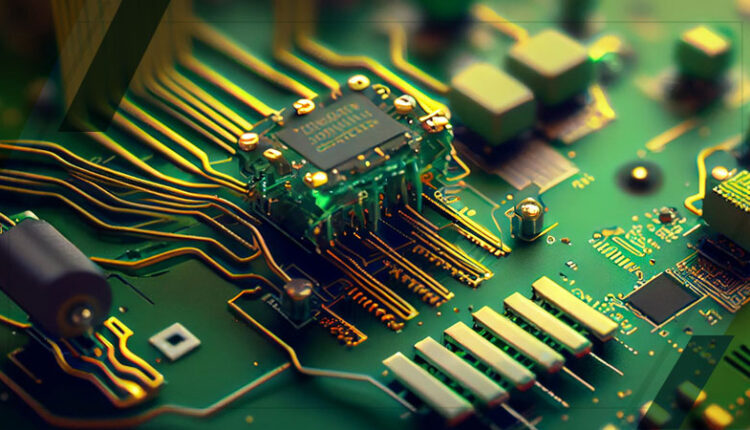Imagine a world without smartphones, laptops, or refrigerators. It looks incomplete, right? What is all this made of? It is the underrated yet extraordinary semiconductor. These unassuming materials are at the heart of every technological marvel, from smartphones to space exploration.
Let’s take a deep dive into this electrifying world together, where science fiction meets reality and where the possibilities are limited only by our imagination.
What is Semiconductor?
We know that we are surrounded by semiconductors, but what are they exactly?
A semiconductor is a material that has a conductivity between conductors and non-conductors, or insulators. This material allows electric current to pass through it under certain conditions like voltage, heat, and light. Gallium arsenide, germanium, boron, silicon, etc. are some of the most commonly known examples.
These materials are favored due to their reliability, compact structure, and cost-effectiveness, as well as their ability to handle a diverse range of voltage and current ratings.
Semiconductors and Their Limitless Applications
Semiconductors play a key role in nearly all areas of electronics. Let us discuss some of them in detail.
● Consumer Electronic Goods
The popularity of consumer electronics like mobile phones, laptops, microwaves, refrigerators, and game consoles heavily relies on semiconductor components, such as integrated chips, diodes, and transistors.
● Embedded Systems
These are compact computers integrated into larger machines, enabling device control and user interaction. Some main applications include central heating systems, digital watches, GPS systems, fitness trackers, televisions, and vehicle engine management systems.
● Thermal Conductivity
Certain semiconductors with high thermal conductivity can be utilized as cooling agents in specific thermoelectric applications.
● Lighting and LED Displays
Certain semiconductors, typically found in liquid or amorphous states as thin-coated films, can generate light and are employed in LEDs and OLEDs.
Seoul Semiconductor Co., Ltd. showcases microLED displays powered by WICOP Pixel technology, which offers the highest brightness in the industry. The technology, the world’s first full-color one-chip, allows three RGB micro LEDs to be stacked vertically, enabling better color reproduction and uniform color representation.
● Solar cells
Silicon is widely used in solar technology for panel cell production. In photovoltaic cells, a semiconductor is present in the wafer, which acts as the substrate for microelectronic devices.
● Printing
Semiconductors are playing a critical role in the printing industry, as they are highly used in 3D printing machines.
● Autonomous Cars
Semiconductors employed in the operation of AI-driven autonomous vehicles in the form of sensors, processors, communication systems, and power management systems help these vehicles work.
Tesla is reportedly partnering with Samsung Electronics to develop advanced self-driving chips for its next-generation electric vehicles (EVs). HW 5.0, the 5th-generation self-driving chip, is expected to use Samsung’s 14nm semiconductors, a significant component in Tesla’s previous FSD (full self-driving) chip.
● Microchips
Microchips, also known as integrated circuits or monolithic integrated circuits, are made from semiconductor silicon and consist of numerous transistors, forming a small, flat piece of silicon.
Semiconductor Industry: Fueling the Technological Revolution of the 21st Century
In the semiconductor sector, achieving success hinges on the ability to develop products that are smaller, faster, and more cost-effective. An advantage of miniaturization is the increased capacity to accommodate higher power on a single chip. As the number of transistors on a chip grows, its performance speed also improves. Consequently, intense competition arises within the industry, driven by emerging innovative technologies that effectively reduce production costs per chip.
For instance, in August 2023, Intel acquired Tower Semiconductor, a leading semiconductor manufacturer based in Israel, in an effort to reduce its reliance on Chinese suppliers and navigate the escalating trade tensions between the United States and China. The acquisition is seen as a strategic move by Intel to secure its supply chain and strengthen its position in the global semiconductor industry.
The semiconductor demand is also increasing due to the high need for cutting-edge and cost-efficient chip manufacturing for a diverse range of industrial applications. As a result, semiconductor companies are required to allocate significant financial resources towards research and development.
Revolutionizing the Digital Frontier
Semiconductors have revolutionized our world and continue to shape the course of technological advancements. From powering our smartphones and computers to enabling breakthroughs in renewable energy and medical devices, they are the unsung heroes behind the scenes. These remarkable materials, with their unique electrical properties, have unlocked endless possibilities and transformed how we live, work, and communicate.
However, the journey of these marvels is far from over. Scientists and engineers are continually pushing the boundaries of what is possible, exploring novel ways to harness their potential. With each breakthrough, we inch closer to a future where the unimaginable becomes reality.


